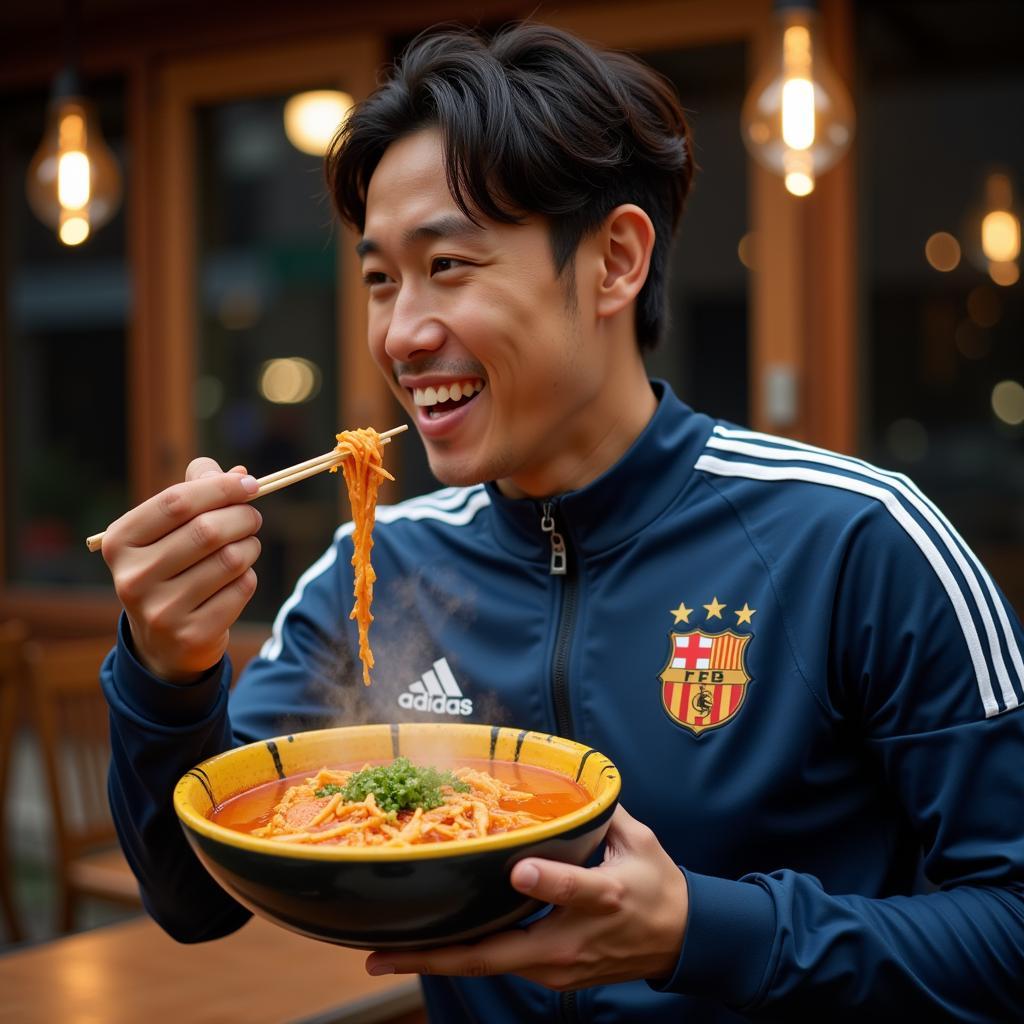Footballer’s Fuel: The Tasy World of Tteokbokki
October 13, 2024Tteokbokki, a beloved Korean street food dish, has taken the world by storm, captivating taste buds with its chewy rice cakes, fiery gochujang sauce, and endless topping variations. But did you know that this spicy delight has also found its way into the hearts, and stomachs, of footballers?
Why Footballers are Saying “Yes” to Tteokbokki
 Footballer Enjoying Tteokbokki for Energy
Footballer Enjoying Tteokbokki for Energy
Professional athletes, especially those in demanding sports like football, need a balanced diet that provides sustained energy, aids muscle recovery, and supports overall performance. While tteokbokki might seem like an unexpected choice, a closer look reveals some surprising benefits:
- Carbohydrate Powerhouse: The dish’s main component, rice cakes, are a great source of carbohydrates, the body’s primary fuel source during intense physical activity.
- Spice Up Recovery: Gochujang, the fermented chili paste that gives tteokbokki its signature kick, contains capsaicin. Capsaicin has anti-inflammatory properties that can aid muscle recovery after strenuous training.
- Nutrient-Packed Additions: Adding vegetables like scallions, onions, and cabbage boosts the nutritional value, providing essential vitamins and minerals. Protein sources like boiled eggs, fish cakes, or lean meat can further enhance the dish’s ability to support muscle growth and repair.
Tteokbokki on the Table: Game Day Rituals and Team Bonding
Beyond its nutritional benefits, tteokbokki also plays a role in fostering team spirit and camaraderie. Many footballers have incorporated this spicy treat into their pre-game rituals or post-match celebrations, creating shared experiences that strengthen team bonds.
“Food, especially something as universally loved as tteokbokki, has a way of bringing people together,” says Park Ji-Sung, a renowned sports nutritionist. “The shared experience of enjoying a meal, especially after a tough training session or a hard-fought game, creates a sense of unity and shared purpose.”
From Street Food to Sports Nutrition: The Evolution of Tteokbokki
While the traditional tteokbokki recipe, laden with gochujang and often cooked with processed fish cakes, might not be the healthiest choice for everyday consumption, it’s important to note that the dish is incredibly versatile. With a few simple tweaks, footballers and health-conscious individuals alike can enjoy a delicious and nutritious bowl of tteokbokki:
- Swap Out the Rice Cakes: Opt for brown rice cakes or quinoa for added fiber and nutrients.
- Go Light on the Gochujang: While a touch of spice is great, using too much gochujang can increase the sodium content. Adjust the amount to your taste and dietary needs.
- Load Up on Veggies: Don’t hold back on the vegetables! Add leafy greens, mushrooms, bean sprouts, or any other favorites for added vitamins, minerals, and fiber.
- Choose Lean Protein: Include grilled chicken breast, tofu, seafood, or boiled eggs to boost the protein content and make it a more complete meal.
Conclusion
Tteokbokki, with its unique blend of spicy, savory, and chewy textures, has earned its place in the hearts and diets of footballers and food enthusiasts worldwide. By understanding its nutritional components and embracing healthier preparation methods, this Korean culinary gem can be enjoyed as part of a balanced and performance-enhancing diet, fueling athletes on and off the field.